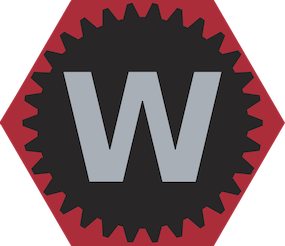WPILib Programming Basics#
Making FRC Programming Easy

What is WPILib#
- The WPI Robotics library (WPILib) is a set of software classes that interfaces with the hardware and software in your FRC RoboRIO.
- There are classes to handle sensors, motor speed controllers, the driver station, and a number of other utility functions.
- Documentation is available at http://first.wpi.edu/FRC/roborio/release/docs/java
- WPILib adds those sensors and controllers as additional data types (like
intordouble) and classes.-
Examples
Talon,Solenoid,Encoder...
-
Command Based Robot#
- For our programming tutorial we will be creating a Command based robot
- Command Based Robots are much like Lego, with very basic pieces you can make something simple like a small house or complicated like an entire Lego city.
- A command based robot is broken down into subsystem classes and command classes.
- In the code, a command based robot is made up of 3 packages (folders) labeled robot, commands, and subsystems
- There are other types of robots but we will use Command Based
Subsystems#
- A subsystem is a special template class made by FRC.
- In robotics, subsystems are sections of the whole robot.
- For example every FRC robot has a Drivetrain subsystem which is what controls the robot’s driving both physically and programmatically.
- To avoid confusion between software and mechanical teams, subsystems should be called the same thing. If we have a ball intake system, we will both call it Intake or Collector.
- Subsystems of a robot can contain parts to control or read data from.
- The Drivetrain subsystem could contain motor controllers and encoders both physically and programmatically.
- For example every FRC robot has a Drivetrain subsystem which is what controls the robot’s driving both physically and programmatically.
- Using a dog as an example: the legs, tail, and head are subsystems.
- The head subsystem has the parts: eyes, ears, and nose.
- When programming subsystems we use variables and methods to tell our subsystem what it has and what it is capable of or should do.
- These variables will be the parts in the subsystem
- These methods will define what those parts are capable of.
- Using a dog head subsystem as an example:
- Some variables (parts) would be: leftEye, rightEye, nose, leftEar, rightEar.
- Some example methods would be closeEyes or openEyes since these are things the dog are capable of.
- These methods would use both the leftEye and rightEye and close them.
-
Example
//This method closes the dog eyes public void closeEyes(){ leftEye.close(); rightEye.close();
- A robot example of a Drivetrain subsystem would have leftMotor, and rightMotor as variables and setSpeed as a method telling it how to set the speed of those motor controllers.
- Having the setSpeed method tells our program that our Drivetrain subsystem can set its speed.
-
Example
//This method sets the speed of the drivetrain public void setSpeed(double speed){ leftMotor.set(speed); rightMotor.set(speed); }
-
Commands#
- A command is a special template class (file) made by FRC.
- In robotics, commands are actions you want a robot to do (just like a real life command).
- A command is an action a subsystem(s) performs.
- For example you may want your robot to drive full speed forward so you make a command class called DriveForward.
- Since a robot uses a Drivetrain subsystem to control its motors, this command would call our previously created setSpeed method from that subsystem.
-
Tip
Subsystems define what the robot is made of and what it can do while commands actually tell the robot to do those things - Using a dog as an example we can tell the dog to blink by creating a BlinkEyes command
- The command would call the method, closeEyes() then the method openEyes()
-
BlinkEyes Command
//This command will continuously run the two methods in execute protected void execute() { dog.head.closeEyes(); dog.head.openEyes(); } - A robot example of a DriveForward command would call (use) the setSpeed methods that we created in the Drivetrain subsystem
- DriveForward, when executed, will tell our robot to drive forward using the Drivetrain subsystem
-
DriveForward Command
//This command tells the robot to drive forward full speed protected void initialize(){ robot.drivetrain.setSpeed(1.0); }
Default Command Structure#
- The template for FRC commands actually come with some pre-defined methods that have special properties for FRC robots, they are:
void initialize()- Methods in here are called just before this Command runs the first time.void execute()- Methods in here are called repeatedly when this Command is scheduled to runboolean isFinished()- When this returns true, the Command stops running execute()void end()- Methods in here are called once after isFinished returns truevoid interrupted()- Methods in here are called when another command which requires one or more of the same subsystems is scheduled to run
-
Tip
It is good practice to callend()ininterrupted()
Overview of execution#
- In FRC programming our main class is Robot.java and all other classes (command files and subsystem files) must be loaded from Robot.java either directly or indirectly
-
Example
Robot.java loads RobotContainer.java, RobotContainer.java loads DriveForward.java.
-
- All subsystem files must be added to RobotContainer.java.
- This loads our subsystems into the code and allow its public methods to be useable by other files such as commands later by typing
RobotContainer.nameOfSubsystem.desiredMethod();
- This loads our subsystems into the code and allow its public methods to be useable by other files such as commands later by typing
New Project Files#
Summary#
- Command based robots are broken down into subsystems and commands
- Subsystems define what the robot is made of and what it can do while commands actually tell the robot to do those things
- All classes must directly or indirectly connect to Robot.java.
- All Subsystems must be added to RobotContainer.java
- RobotMap.java holds port numbers and IDs accessible throughout the program by typing:
RobotMap.NameOfMotor() - RobotContainer.java contains our publicly accessible instances of our subsystems. It also connects our commands to physical controllers.